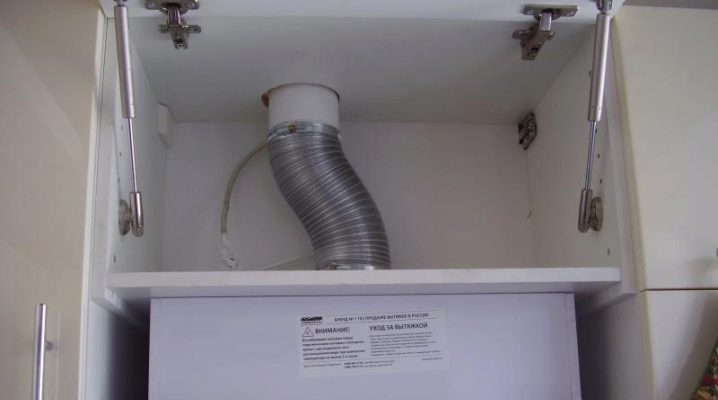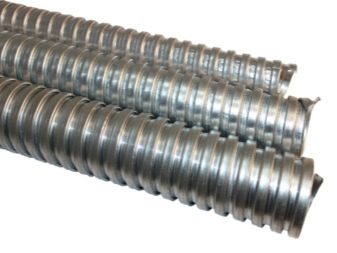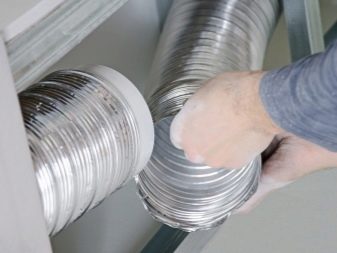The choice of corrugation for the hood

Nowadays, when designing kitchen facilities, it is quite difficult to do without modern exhaust systems. The ventilation ducts promote optimal air circulation, absorb steam and various combustion products, which prevents pollution of the surrounding space and the accumulation of a layer of fat on household appliances and other kitchen furniture.


Peculiarities
Corrugation is a complex of rings covered with protective material. The components of such a pipe are pressed against each other, and the top layer is folded like an accordion. This allows the corrugated tube to stretch in length, exceeding the folded size by several times. Due to the lack of a rigid frame, the structure can bend at almost any angle, which makes it possible to use it for installation in hard-to-reach places and very cramped conditions.
The appearance of such corrugated pipes also had a positive effect on the quality of the work itself.that provide an optimal indoor climate. Previously, rigid duct structures were used with individual parameters separately for each room, which had to be ordered from special companies. It turned out to be very expensive, not everyone could afford to purchase such devices.



Also, the advantages of using corrugated pipes in ventilation systems include the following properties:
- long service life;
- simplification of installation work;
- availability to purchase;
- wide range of standard sizes;
- the ease of the design itself;
- resistance to high temperatures, which excludes fire;
- optimal aerodynamic performance.



If we talk about the shortcomings, then they include the following points:
- it is quite difficult to clean a pipe with a corrugated surface;
- not very presentable appearance, which requires masking of the corrugation;
- aluminum corrugated pipes can lose their original shape during installation work due to the softness of the material, they have a high level of noise during the operation of the exhaust system.



The main technical characteristics (parameters) of corrugated pipes include their actual dimensions, such as the cross-sectional diameter and the length of the structure, which is determined directly by the manufacturing plant. It can correspond to a standard size or be sold in bays from 20 to 100 m.
The choice of diameter is directly influenced by the power of the device itself.
The most common corrugated pipes have the following parameters:
- 100 mm;
- 120 mm;
- 125 mm;
- 150 mm.
You can find out which diameter to choose from the passport or the instructions for the hood, where recommendations on the section are given. It should be taken into account that it is absolutely impossible to take a corrugated air duct of a smaller diameter, a larger one can be taken. But in this case, you need to additionally take an adapter in order to avoid a situation when the pipe cannot dock with the neck.


It should also be taken into account that the length of the corrugation is chosen according to the size in the stretched form, since the installation takes place exactly like this, and it is sold compressed. Since part of the length is always spent on the formation of bends, the pipe is purchased with a margin of 0.5 m for every 2-3 straight turns.
It is permissible to use the option of a frame corrugation with a foil coating, but this option is highly undesirable. Despite the fact that this option is much cheaper, foil is a fragile material that can be easily damaged and punctured.And a very thin foil has the ability to constantly rustle, even if the hood is off.
It is recommended to ask the employees of specialized stores for a quality certificate for the purchased product. This will prevent the possibility of buying goods from dubious manufacturers that do not have any accompanying documents and may turn out to be full of holes. The slots are usually microscopic in size and therefore difficult to detect before the start of the operation.
When making a purchase, you need to check whether the purchased kitchen hood system already has a check valve built into it, if not, you must additionally take it.



Views
The type of room where the air duct is planned to be installed directly depends the choice of a corrugated pipe, namely the shape of its section, which are:
- rectangular or square;
- round or flat (oval).
A corrugated pipe with a rectangular (square) cross-section is usually used in various enterprises and factories, serves as a good option for arranging ventilation systems for various technical and warehouse premises, as well as common areas. The cross-sectional diameter of such pipes is much larger than that of rounded ones.
For home use, in particular, when arranging a kitchen ventilation system, the best option would be a corrugated pipe that is round in shape, usually white PVC is taken. It is much easier to install it yourself, and its cost is much less than a rectangular one.




Corrugated air ducts differ not only in their shape, but also in the method of their manufacture.
According to this criterion, they are divided into two main types:
- frame;
- spiral wound corrugated pipes.
The first type is a base of metal rings and aluminum foil or polymer film stretched over them. Such pipes tend to take their original form and do not allow deformation after being stretched to their full length, and therefore they are considered the most flexible.
Spiral-wound air ducts are mostly made of galvanized or stainless steel, aluminum. This type of construction has a high cost compared to corrugated pipes of the first type (frame). They are half flexible due to the fact that they can fully stretch two or three times, but do not have the property of returning to their original state. Deformation will remain inevitable, even if efforts are made to give such a duct the desired shape.


Some manufacturers offer flexible corrugated pipe with or without insulation. Endowing the structure with thermal insulation properties helps to significantly expand the scope of such air ducts. For example, when using four-layer flexible corrugated pipes, it becomes possible to lay ventilation ducts not only indoors, but also outside.



Materials (edit)
In practice, corrugated pipes from the following materials are used:
- aluminum;
- stainless steel;
- Cink Steel;
- low or high pressure polyethylene;
- textile;
- polyvinyl chloride (PVC).



The type of material from which the duct is made directly affects the scope of its application.
- For example, textile pipes are used when wiring communication systems in industrial premises, since they contribute to a sufficiently high speed of air circulation. It is this factor that determines the use of textile corrugated pipes in catering and meat processing plants. Such structures can be easily dismantled, cleaned and disinfected.
- Air ducts made of polyvinyl chloride or PVC corrugated pipes are used mainly for arranging ventilation ducts in houses and industrial facilities. Mineral fillers are used here to ensure maximum sound insulation.
- Most often, corrugated pipes made of stainless steel, galvanized steel or aluminum are taken to equip a kitchen hood. Less commonly, plastic options are used.
- The aluminum corrugated pipe has a frame of medium rigidity and a fairly low weight. It is used both outside and inside premises. It has grooves for fastening, which are not available in cheaper options. The advantages of installing pipes made of this material include durability during operation and resistance to almost any weather conditions. But there are also minor flaws: vibration of the pipe during operation and the formation of noise.
- The next option is a flexible pipe with a metal wire frame with foil wrapped around it. The duration of operation and the quality of such a duct is directly affected by the thickness of the outer layer. It is used only in everyday life, as it can withstand small loads. The advantages include flexibility and the most affordable price, the disadvantages are the low level of safety and practicality.
- Galvanized steel corrugated pipes usually serve for a very long time (more than 20 years). Pipes can be with or without polymer coating. The polymer layer protects the inside or outside of the pipe, and this option also provides a choice of colors and fits harmoniously into any interior. The advantages of using galvanized ventilation ducts include high strength, long service life even with strong heating (over 70 degrees), absolute incombustibility, a choice of colors, and minimal network resistance. The disadvantage is the lack of components that serve to fasten several pipes together. You have to use tools like pliers or wire cutters.


- Plastic corrugated pipe is the most budgetary and optimal option for simple installation work in residential premises. But such a material has several significant disadvantages: a very high degree of flammability (in a fire, acrid smoke will be released, which will lead to poisoning with toxic and poisonous substances), great vulnerability and degradability, the release of an unpleasant odor due to the presence of formaldehyde in the composition. The advantages include the low cost of the finished product, ease of installation, minimal network resistance.


Installation and connection
Installation of a corrugated pipe is carried out in several stages.
- It is necessary to develop a detailed scheme for installing the hood. At this stage, it is worth considering all the features of the kitchen, the location of the furniture compartments, determining the place for the ventilation duct and drawing up a plan for its installation. After that, calculate the required number of pipes, gratings and fasteners.
- Check the lengths of all components carefully. In accordance with the drawn diagram and the selected parameters, prepare the sleeves for installation work. The corrugated pipe can be made shorter using ordinary scissors or a hacksaw.
- Install a universal reducer on the exhaust outlet. This device is required for mounting corrugated pipes of different diameters.
- Connect the corrugated pipes to the hood. Lubricate the edges of the hood mouth with sealant. Fasten the pipe and then the clamp with the screw and screwdriver.
- Attach the corrugated pipe to the wall using brackets with clamps. Clamps are fastened at a distance of 1 m from each other along the entire length of the duct.
- Place the ventilation grill on the shaft opening and fix with self-tapping screws.
- Connect the air duct to the grille. Apply sealant to the flare of the grille and put on the neck of the air duct. Secure with a hose clamp.
- Connect the hood to the mains and check the quality of the entire system.
- Mask the corrugated pipe, if necessary.




In the event that the exhaust system is located quite far from the ventilation opening, it is recommended to hide the corrugated pipe behind a stretch ceiling. This option will help to avoid the formation of too sharp corners and hide the duct from prying eyes.
If it is not planned to install a stretch ceiling in the kitchen, then you can hide the duct in the following ways:
- close the pipe with the doors of the wall cabinets;
- mount the air duct behind the plasterboard structure;
- close it with a decorative box or other element in accordance with the interior of the kitchen.
Before starting the installation work, it is recommended to clean the ventilation in the apartment itself and determine if there is a draft. To check this fact, you need to attach a regular sheet of paper to the ventilation hole. In the event that he holds on without outside help, the craving is present.


It is also important to establish the most suitable performance of the cooker hood, which is very easy to check using a special device - an anemometer built into the base of the corrugated pipe.
And the last thing - do not forget about the elementary fire safety rules. It is worth strictly adhering to the operating instructions for the selected equipment and to be careful not to get moisture on the surface of the exhaust system while the fan is running.
It is highly undesirable to carry out the following actions:
- touch with wet hands the metal surface of the hood or corrugated foil-coated pipe;
- use detergents when cleaning the air duct;
- install a corrugated pipe near a gas and electric stove or fireplace;
- fix the duct near the electrical wiring.
Thus, almost everyone can cope with the installation of a corrugated pipe, you just need to choose the right parameters (length and diameter), shape and material of the duct, and also take into account the peculiarities of the kitchen interior.
For a video review of the ductwork for a kitchen hood, see the video below.













The comment was sent successfully.